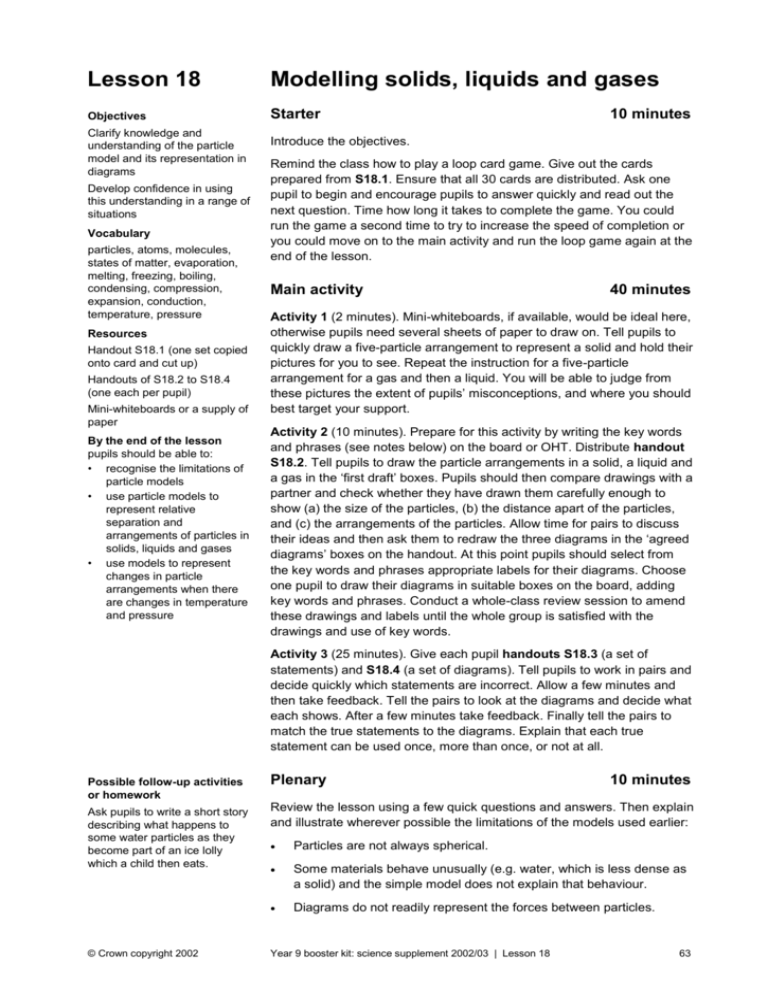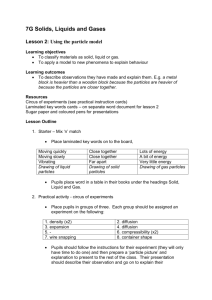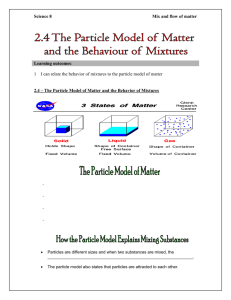Lesson 18 Modelling solids, liquids and gases
advertisement

Lesson 18 Modelling solids, liquids and gases Objectives Starter Clarify knowledge and understanding of the particle model and its representation in diagrams Develop confidence in using this understanding in a range of situations Vocabulary particles, atoms, molecules, states of matter, evaporation, melting, freezing, boiling, condensing, compression, expansion, conduction, temperature, pressure Resources Handout S18.1 (one set copied onto card and cut up) Handouts of S18.2 to S18.4 (one each per pupil) Mini-whiteboards or a supply of paper By the end of the lesson pupils should be able to: • recognise the limitations of particle models • use particle models to represent relative separation and arrangements of particles in solids, liquids and gases • use models to represent changes in particle arrangements when there are changes in temperature and pressure 10 minutes Introduce the objectives. Remind the class how to play a loop card game. Give out the cards prepared from S18.1. Ensure that all 30 cards are distributed. Ask one pupil to begin and encourage pupils to answer quickly and read out the next question. Time how long it takes to complete the game. You could run the game a second time to try to increase the speed of completion or you could move on to the main activity and run the loop game again at the end of the lesson. Main activity 40 minutes Activity 1 (2 minutes). Mini-whiteboards, if available, would be ideal here, otherwise pupils need several sheets of paper to draw on. Tell pupils to quickly draw a five-particle arrangement to represent a solid and hold their pictures for you to see. Repeat the instruction for a five-particle arrangement for a gas and then a liquid. You will be able to judge from these pictures the extent of pupils’ misconceptions, and where you should best target your support. Activity 2 (10 minutes). Prepare for this activity by writing the key words and phrases (see notes below) on the board or OHT. Distribute handout S18.2. Tell pupils to draw the particle arrangements in a solid, a liquid and a gas in the ‘first draft’ boxes. Pupils should then compare drawings with a partner and check whether they have drawn them carefully enough to show (a) the size of the particles, (b) the distance apart of the particles, and (c) the arrangements of the particles. Allow time for pairs to discuss their ideas and then ask them to redraw the three diagrams in the ‘agreed diagrams’ boxes on the handout. At this point pupils should select from the key words and phrases appropriate labels for their diagrams. Choose one pupil to draw their diagrams in suitable boxes on the board, adding key words and phrases. Conduct a whole-class review session to amend these drawings and labels until the whole group is satisfied with the drawings and use of key words. Activity 3 (25 minutes). Give each pupil handouts S18.3 (a set of statements) and S18.4 (a set of diagrams). Tell pupils to work in pairs and decide quickly which statements are incorrect. Allow a few minutes and then take feedback. Tell the pairs to look at the diagrams and decide what each shows. After a few minutes take feedback. Finally tell the pairs to match the true statements to the diagrams. Explain that each true statement can be used once, more than once, or not at all. Possible follow-up activities or homework Plenary Ask pupils to write a short story describing what happens to some water particles as they become part of an ice lolly which a child then eats. Review the lesson using a few quick questions and answers. Then explain and illustrate wherever possible the limitations of the models used earlier: © Crown copyright 2002 10 minutes Particles are not always spherical. Some materials behave unusually (e.g. water, which is less dense as a solid) and the simple model does not explain that behaviour. Diagrams do not readily represent the forces between particles. Year 9 booster kit: science supplement 2002/03 | Lesson 18 63 Particles: key words and phrases With reference to particle size the key words are: • bigger; • smaller; • same shape; • different shape. With reference to the distance apart of particles the key phrases are: • distance apart increasing; • distance apart decreasing. With reference to the arrangement of particles the key words and phrases are: • regular pattern; • random. During activity 2 of the main part of the lesson, pupils should use some or all of these labels in any way they wish on handout S18.2 in order to add extra detail about the particle arrangements in solids, liquids and gases. © Crown copyright 2002 Year 9 booster kit: science supplement 2002/03 | Lesson 18 64 Card loop game S18.1 Cooling a gas slows down the movement of its particles and the pressure will … Squeezing air quickly in a bicycle pump raises the pressure and causes a rise in … melting decrease The temperature at which a solid becomes a liquid is called the … All matter is composed of … temperature melting point All particles in a substance have kinetic energy and … Condensation happens because … particles move or vibrate Substances expand when heated because their particles … In these two states of matter the particles are close together the water particles move more slowly move further apart This type of substance does not have a fixed melting point In these two states of matter the particles can move freely about solids and liquids mixture Changing a gas to a liquid is called … This gas forms about four fifths of air (80%) liquids and gases condensation © Crown copyright 2002 Year 9 booster kit: science supplement 2002/03 | Lesson 18 65 Squeezing a gas to turn it into a liquid is called … This gas forms about one fifth of air (20%) nitrogen compression Cooling a gas will cause its particles to move … This gas forms about 0.5% of air oxygen more slowly Freezing is the result of cooling a … Heating a gas will cause its particles to … carbon dioxide liquid Air particles striking the wall of a container cause … When a gas is compressed its pressure will … move more quickly air pressure These substances retain their shape This substance is used in hydraulics because it does not easily compress increase solids Particles in a solid do not … Particles can be made to move further apart by … water change position easily © Crown copyright 2002 Year 9 booster kit: science supplement 2002/03 | Lesson 18 66 A liquid does not have a fixed shape because … Changing a liquid to a gas is called … heating the particles can move around each other easily Particles in a gas are … Changing a liquid to a solid is called … evaporation far apart This sort of substance is easily compressed Changing a solid to a liquid is called … solidification gas © Crown copyright 2002 Year 9 booster kit: science supplement 2002/03 | Lesson 18 67 © Crown copyright 2002 Year 9 booster kit: science supplement 2002/03 | Lesson 18 68 Arrangements of particles © Crown copyright 2002 Year 9 booster kit: science supplement 2002/03 | Lesson 18 S18.2 69 © Crown copyright 2002 Year 9 booster kit: science supplement 2002/03 | Lesson 18 70 True or false? S18.3 1 Particles are further apart when the substance is a gas. 2 Particles are all circular (or spherical). 3 Particles move faster when the substance is a gas. 4 Heating a liquid increases the distance between particles. 5 Heating a liquid makes it evaporate more quickly. 6 Heating a solid makes the individual particles expand. 7 Compressing a gas makes the particles move closer together. 8 All substances are made of particles. © Crown copyright 2002 Year 9 booster kit: science supplement 2002/03 | Lesson 18 71 © Crown copyright 2002 Year 9 booster kit: science supplement 2002/03 | Lesson 18 72 Particle diagrams © Crown copyright 2002 Year 9 booster kit: science supplement 2002/03 | Lesson 18 S18.4 73 © Crown copyright 2002 Year 9 booster kit: science supplement 2002/03 | Lesson 18 74








